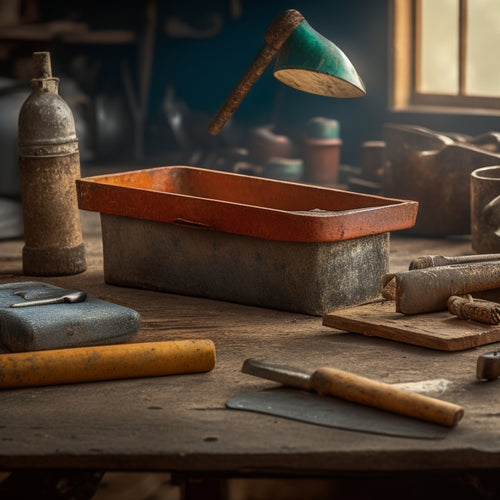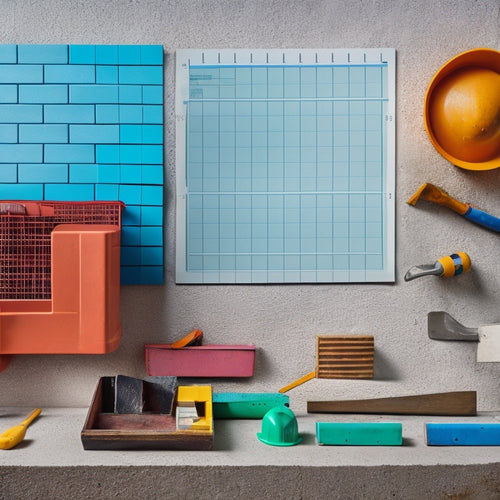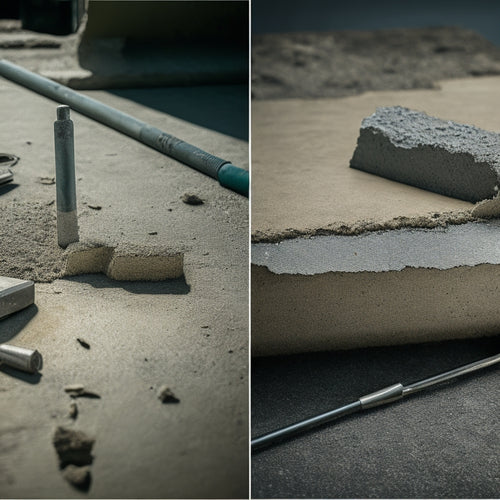
7 Best Hand Tools for Laying Concrete Blocks
Share
When laying concrete blocks, you'll need the right hand tools to guarantee a professional-looking finish. Seven essential tools will help you achieve a smooth, accurate, and durable structure. Start with a high-quality trowel for smooth finishes, a heavy-duty hammer for efficient block breaking, and a spirit level for accurate alignment. A pointing trowel is necessary for precise mortar application, while a joint raker helps create neat joints. A block cutter guarantees precise cuts, and a rubber mallet allows for gentle tapping to secure blocks. With these tools in your arsenal, you'll be well on your way to a successful block-laying project, and understanding their proper use will take you to the next level of expertise.
Key Takeaways
• High-quality trowels ensure smooth, even finishes free of imperfections, making them essential for laying concrete blocks.
• Heavy-duty hammers are necessary for clean and efficient block breaking, with proper technique involving 45-degree angle and controlled glancing blows.
• A spirit level is crucial for ensuring accurate block alignment, with types including bubble, laser, and digital levels for various needs.
• Pointing trowels are vital for precise mortar application between blocks, with proper mortar consistency and gentle, sweeping motion recommended.
• Joint rakers are used to remove excess mortar for a professional finish, with uniform joint creation vital for structural integrity and appearance.
Essential Trowel for Smooth Finishes
When laying concrete blocks, you're relying on a high-quality trowel to assure a smooth, even finish that's free of imperfections. A good trowel is fundamental for achieving the perfect finish, and it's important to choose the right one for the job. With the right trowel techniques, you can guarantee a professional-looking finish that's both durable and aesthetically pleasing.
To get the best results, it's essential to hold the trowel at the correct angle, applying gentle to moderate pressure depending on the type of concrete you're working with. This will help you achieve a smooth, even layer that's free of air pockets and bubbles.
As you work, make sure to keep the trowel clean and free of debris, as this can affect the finish. When adding the finishing touches, use your trowel to create a smooth, uniform surface. This is where attention to detail is important, as any imperfections will be noticeable.
Heavy-Duty Hammer for Block Breaking
You'll need a heavy-duty hammer with sufficient force and control to break concrete blocks cleanly and efficiently, without shattering or damaging them. For this task, you'll want to choose from three primary hammer types: a sledgehammer, a demo hammer, or a block hammer. Each type is designed for specific breaking techniques and offers varying levels of force and precision.
When selecting a hammer, consider the block's size, material, and the level of demolition required. A sledgehammer is ideal for larger blocks and more aggressive breaking, while a demo hammer provides a balance between force and control. A block hammer, with its smaller head and lighter weight, is perfect for more precise breaks and smaller blocks.
To break blocks effectively, use proper breaking techniques. Hold the hammer at a 45-degree angle, striking the block's center with a controlled, glancing blow. This will help you achieve a clean break while minimizing damage to the surrounding area.
Remember to always wear safety gear, including gloves and safety glasses, when working with heavy-duty hammers and concrete blocks.
Spirit Level for Accurate Alignment
Your spirit level is vital for guaranteeing accurate alignment of the concrete blocks, as even the slightest deviation from level can lead to structural instability and compromised integrity.
You'll want to choose from the various spirit level types available, including bubble, laser, and digital levels, depending on your specific needs and preferences. Bubble levels are the most common, providing a visual indication of levelness, while laser levels offer higher precision and accuracy over longer distances. Digital levels, on the other hand, provide precise numeric readings.
Regardless of the type you choose, proper spirit level maintenance is essential to guarantee accuracy. Regularly check your level for damage, cleanliness, and calibration. Clean the level's vials and lenses regularly, and store it in a protective case when not in use. Calibration should be performed according to the manufacturer's instructions, and any adjustments made as needed.
Pointing Trowel for Mortar Application
With the concrete blocks aligned accurately using your trusty spirit level, it's time to focus on applying the right amount of mortar to hold them in place, and that's where a pointing trowel comes in.
A pointing trowel is a must-have tool for any concrete block laying project, as it allows you to apply mortar with precision and control. When choosing a pointing trowel, look for one with a sturdy handle and a notched blade that's designed for scooping and spreading mortar.
Here are three key things to keep in mind when using a pointing trowel for mortar application:
-
Mortar consistency: Make sure the mortar is at the right consistency for application. If it's too wet, it'll be difficult to work with; if it's too dry, it won't hold the blocks in place.
-
Pointing techniques: Use a gentle, sweeping motion to apply the mortar, holding the trowel at a 45-degree angle to the block.
-
Amount control: Use the notched blade to scoop up the right amount of mortar, and then spread it evenly onto the block, making sure to fill the gaps completely.
Joint Raker for Neat Finishing
Once the blocks are laid, a joint raker is essential for removing excess mortar from between the blocks, ensuring a neat and professional finish.
You'll want to use the joint raker to create a uniform joint, which is vital for the structural integrity and appearance of the wall. To get the best results, use joint raker techniques that involve holding the tool at a 45-degree angle and gently raking it along the joint. This will help remove excess mortar and create a clean, defined edge.
When using a joint raker, it's important to work in small sections, about 3-4 feet at a time, to maintain control and avoid spreading excess mortar.
Additionally, joint finishing tips suggest that you should rake the joint in one direction only, following the direction of the block courses. This helps prevent mortar from being pushed back into the joint, ensuring a clean and even finish.
Block Cutter for Precise Cutting
Every concrete block laying project requires a reliable block cutter to make precise cuts, ensuring a snug fit and minimizing waste. You need a tool that can accurately cut blocks to fit around obstructions, corners, and edges. A good block cutter will help you master various cutting techniques, such as diagonal, curved, and straight cuts.
Here are three key features to look for in a block cutter:
-
Adjustable cutting depth: This allows you to cut blocks of varying sizes and shapes with precision.
-
Durable blades: High-carbon steel or tungsten carbide blades will withstand the rigors of frequent use and maintain their sharpness.
-
Ergonomic design: A comfortable grip and balanced design will reduce fatigue and improve control during extended use.
When choosing a block cutter, consider the type of block sizes you'll be working with most frequently. A versatile cutter that can handle standard block sizes, such as 8x8 and 12x12, will be a valuable addition to your toolkit.
With the right block cutter, you'll be able to make precise cuts, reduce waste, and complete your project efficiently.
Rubber Mallet for Gentle Tapping
You'll need a rubber mallet to gently tap blocks into place, ensuring a secure fit without damaging the surrounding material. When using a rubber mallet, it's crucial to develop proper mallet techniques to achieve the best results.
Start by holding the mallet with a firm grip, but not too tight, allowing for controlled movements. As you tap the block, focus on establishing a consistent tapping rhythm, applying gentle to moderate force depending on the block's size and weight.
To avoid applying too much pressure, practice tapping with a light touch, gradually increasing the force as needed. This will help you gauge the block's movement and prevent damage to the surrounding material. Remember, the goal is to coax the block into place, not force it.
Frequently Asked Questions
What Safety Gear Is Recommended for Concrete Block Laying?
When working with concrete blocks, you must prioritize your safety.
You're at risk of eye injuries from flying debris and heavy blocks, so you'll need safety goggles with impact-resistant lenses.
Additionally, you'll be lifting and moving heavy loads, making steel toe boots a must-have to protect your feet from crush injuries.
Wearing this essential gear will help prevent serious harm and guarantee a safe working environment.
Can I Use a Regular Hammer for Block Breaking?
When it comes to breaking concrete blocks, you can't just use any regular hammer.
You'll need a specialized hammer designed for the task, such as a block hammer or a lump hammer. These hammers have a wedge-shaped head that concentrates force for efficient block breaking.
Additionally, consider investing in block chisels, which are specifically designed for splitting and breaking concrete blocks.
How Do I Mix Mortar for Concrete Block Laying?
Imagine mixing a perfect recipe, where ingredients blend harmoniously. That's what you're aiming for when mixing mortar for concrete block laying.
To achieve the ideal consistency, start by combining 1 part cement to 2.5 parts sand.
Add water gradually, using a mixing technique called 'gauging,' until the mix reaches a workable, not-too-wet, not-too-dry state. You're looking for a consistency similar to thick cream.
What Is the Ideal Temperature for Laying Concrete Blocks?
When laying concrete blocks, you need to take into account the temperature effects on the mortar and the blocks themselves.
Ideally, you're working in temperatures between 40°F and 90°F (4°C and 32°C), with a prime range of 50°F to 70°F (10°C to 21°C). This guarantees the mortar sets properly and the blocks cure correctly.
Avoid extreme temperatures, as they can affect the bond between the mortar and blocks, leading to structural weaknesses.
Can I Lay Concrete Blocks in the Rain or Wet Conditions?
You're walking on thin ice when laying concrete blocks in the rain or wet conditions.
The impact of moisture can be a silent saboteur, compromising the curing process and ultimately, the structural integrity of your blockwork. Water can seep into the mix, weakening the bond between blocks, and accelerating erosion.
It's a recipe for disaster. To avoid a crumbling foundation, wait for dry conditions or take necessary precautions to guarantee a watertight setup.
Conclusion
You've got the right tools for the job, now it's time to get to work.
With these 7 essentials, you'll be laying concrete blocks like a pro. Remember, precision is key.
Take, for instance, the construction of the iconic One World Trade Center in New York City, where precise block laying was vital to its structural integrity.
By following the same principles, you'll achieve professional results that stand the test of time.
Get building!
Related Posts
-

Smart Guide to Buying Used Concrete Hand Tools
You're about to buy used concrete hand tools, and you need to get it right. Dedicate time to identify the tools you n...
-

Reinforcement Tools Checklist for Concrete Block Walls
You'll need a range of reinforcement materials, including horizontal and vertical rebar, fiber mesh, and anchor bolts...
-

Top Tools for Concrete Adhesion Success
When it comes to concrete adhesion success, you'll need to wield the right tools and techniques to guarantee a strong...


